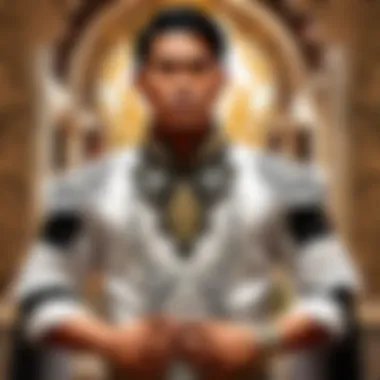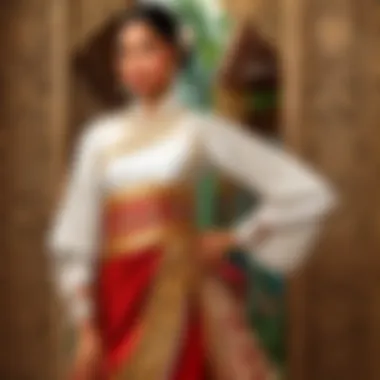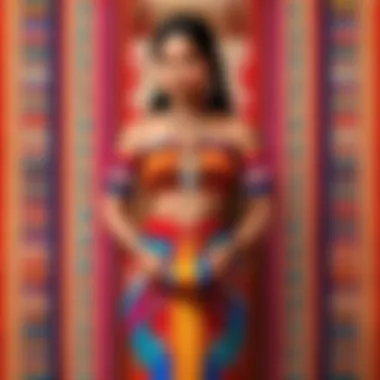Exploring the Intricate World of Traditional Filipino Cultural Attire


Game Overview
As we embark on our exploration of traditional Filipino clothing, we step into a world adorned with the exquisite tapestries of cultural attire. Each garment we encounter on this journey serves as a portal to the diverse heritage of the Philippines, speaking volumes through intricate designs and profound symbolic meanings. These clothing pieces are more than fabric; they are living testaments to centuries of tradition and history, offering us a vivid peek into the vibrant tapestry of Filipino fashion.
Strategy Guides
In our quest to unravel the depths of traditional Filipino clothing, we uncover not just fabric and thread but a narrative woven with the threads of time. From unveiling the subtle nuances of design to decoding the hidden symbolism within each garment, we guide you through a comprehensive understanding of the cultural significance attached to Filipino fashion. Our exploration transcends mere attire; it delves into the very soul of a nation, encapsulating the essence of tradition and history within every stitch.
Patch Updates
Just as patterns evolve and designs transform in the fashion world, traditional Filipino clothing undergoes its own metamorphosis over time. Through a summary of the evolution in styles, fabrics, and techniques, we shed light on the changes that have shaped Filipino fashion through the ages. From the influence of colonialism to the modern interpretations of traditional attire, our analysis spans the spectrum of sartorial transformation, offering insights into the dynamic nature of Filipino cultural identity.
Esports Coverage
Much like the competitive landscape of esports, where strategies shift and players adapt, traditional Filipino clothing reflects a cultural mosaic of diversity and innovation. We delve into the intersection of tradition and modernity, exploring how contemporary Filipino designers blend ancestral motifs with contemporary aesthetics. Through a lens of cultural evolution, we witness the fusion of heritage and haute couture, presenting a narrative of Filipino fashion that is both timeless and trendsetting.
Player Community
In the vast tapestry of traditional Filipino clothing, we encounter not just garments but stories - tales of craftsmanship, resilience, and heritage. Each piece of attire carries with it the history of a people, woven into its very fibers. From the intricate patterns of the T'boli tribe to the sophisticated embroidery of the Barong Tagalog, we celebrate the diversity and artistry of Filipino fashion, inviting you to immerse yourself in a world where every stitch tells a story.
Introduction to Traditional Filipino Clothing
In delving into the fascinating realm of traditional Filipino clothing, we embark on a journey through the intricate tapestry of cultural attire that serves as a vivid reflection of the diverse heritage enshrined in the heart of the Philippines. Each garment encapsulates a unique narrative of tradition and history, offering a window into the vibrant tapestry of the past, imbibing a kaleidoscope of colors, designs, and symbolism.
Historical Significance of Clothing in Filipino Culture
Influences of Pre-Colonial Era
The influences of the Pre-Colonial Era stand as pillars in the foundation of Filipino traditional clothing, echoing an era of indigenous craftsmanship and ingenuity. The utilization of natural materials, intricate weaving techniques, and rich symbolism characterize this epoch, bestowing upon Filipino attire a sense of rootedness and authenticity that transcends time and conquests.
Spanish Colonial Influence
The Spanish Colonial Influence, with its introduction of intricate embroidery and European silhouettes, left an indelible mark on Filipino sartorial heritage. This fusion of European and indigenous aesthetics birthed the iconic Barong Tagalog, symbolizing elegance and national identity. The infusion of Spanish influences added a layer of sophistication and artistry, creating attire that straddles the line between tradition and modernity.
American Colonial Period
The American Colonial Period ushered in a new chapter for Filipino clothing, blending Western influences with local sensibilities. This era witnessed the integration of American styles and fabrics, leading to a subtle evolution in Filipino attire. While some lamented the dilution of indigenous practices, others embraced this fusion as a testament to the resilience and adaptability of Filipino fashion.
Role of Clothing in Traditional Celebrations


Feast Days and Festivals
Feast days and festivals serve as vibrant occasions for showcasing the splendor of Filipino attire, with communities adorning themselves in colorful and ornate ensembles. These celebrations highlight the social fabric and cultural unity woven into the threads of traditional clothing, underscoring the significance of heritage and identity in festive revelries.
Weddings and Milestone Events
Weddings and milestone events mark pivotal moments in Filipino life, where clothing plays a central role in narrating stories of love and tradition. From elaborate gowns to intricately embroidered barongs, these occasions serve as a canvas for showcasing the finest of Filipino craftsmanship, symbolizing prosperity, honor, and familial ties.
Religious Ceremonies
In religious ceremonies, attire takes on a sacred dimension, with specific garments denoting spiritual significance and reverence. The fusion of faith and fashion manifests in exquisite details and symbolic motifs, reflecting a deep-rooted connection to spirituality and cultural practices. Garments worn during religious rites serve as vessels of tradition, carrying the weight of centuries-old beliefs and rituals.
Materials and Techniques Used in Filipino Attire
Abel Cloth and Piña Fabric
Abel cloth and piña fabric stand as pillars of Filipino textile heritage, woven with precision and passion by artisanal weavers. The intricate patterns and luxurious textures of abel and piña speak to the craftsmanship and artistry embedded in Filipino clothing traditions, bridging the gap between innovation and heritage.
Embroidery and Beadwork
Embroidery and beadwork adorn Filipino attire with exquisite embellishments, narrating stories of heritage and artistry through intricate stitches and vibrant hues. These techniques add depth and character to garments, transforming plain fabrics into masterpieces of design and cultural significance.
Weaving Traditions
Weaving traditions form the tapestry of Filipino culture, with each region boasting unique weaving techniques and motifs passed down through generations. The rhythmic clack of the loom echoes the rich history and identity woven into every fabric, celebrating the beauty of diversity and artisanship embedded in Filipino attire.
Diverse Styles of Filipino Traditional Clothing
Traditional Filipino clothing boasts a diverse array of styles that reflect the rich cultural heritage of the Philippines. Each garment showcases intricate designs and symbolic meanings, offering a vibrant glimpse into the colorful past of Filipino fashion. Keeping a keen eye on the specific elements, benefits, and considerations of these diverse styles is crucial for a comprehensive understanding of this article.
Barong Tagalog: The National Attire of the Philippines
Design Elements of Barong Tagalog
Exploring the intricate design elements of the Barong Tagalog unveils a world of craftsmanship and heritage. The unique embroidery patterns and lightweight fabric make it a popular choice for formal occasions. Its sheer elegance and symbolic significance render it a timeless classic in Filipino attire. Understanding the minute details of the barong's design offers a deeper appreciation for the artistry and cultural importance embedded in this exquisite garment.
Occasions for Wearing Barong
The occasions calling for the donning of the Barong Tagalog are steeped in tradition and formality. From weddings to national events, this attire symbolizes pride and respect for Filipino culture. Its versatility allows it to transition seamlessly from formal gatherings to casual affairs, showcasing its adaptability and significance in various social settings. Recognizing the significance of these occasions sheds light on the intrinsic value of the Barong Tagalog in preserving Filipino heritage.
Maria Clara Dress: A Symbol of Elegance


Origins and Evolution
The Maria Clara dress exudes elegance and grace, symbolizing the fusion of Filipino and Spanish influences. Its evolution over time reflects societal changes and fashion trends while maintaining its timeless charm. The intricate details and delicate fabrics used in creating this dress embody the essence of sophistication and femininity, making it a beloved symbol of Filipino cultural pride.
Influence in Modern Fashion
The Maria Clara dress continues to inspire modern fashion with its graceful silhouette and intricate embroidery. Designers worldwide draw inspiration from its classic appeal, incorporating elements of the Maria Clara dress into contemporary clothing pieces. Its influence in the fashion industry highlights the enduring legacy of traditional Filipino attire and its relevance in a constantly evolving sartorial landscape.
Terno: Fusion of Traditional and Modern
History of Terno
The Terno represents a harmonious blend of traditional craftsmanship and modern aesthetics. Its history is steeped in innovation and creativity, with designers pushing boundaries to reinvent this iconic garment. The Terno's evolution showcases a dynamic fusion of cultural heritage and contemporary style, transforming it into a symbol of Filipino identity and creativity.
Iconic Terno Designs
Iconic Terno designs captivate with their bold silhouettes and intricate details, making a statement on runways and red carpets globally. The fusion of traditional elements with modern sensibilities creates a visual feast for fashion enthusiasts. Embracing the iconic Terno designs celebrates Filipino artistry and craftsmanship, underscoring the enduring allure of this distinctive attire.
Significance and Symbolism in Filipino Garments
Significance and Symbolism in Filipino Garments play a vital role in understanding the cultural depth of Filipino clothing. Each garment holds a story beyond its aesthetic value, reflecting the rich heritage and traditions of the Philippines. The intricate designs and symbolic meanings woven into the fabrics convey deeper layers of significance, making Filipino attire more than just cloth and thread. By exploring the symbolism in these garments, one can uncover the history, beliefs, and values embedded in Filipino culture, offering a profound insight into the people and their traditions.
Colors and Patterns in Filipino Clothing
Meaning of Common Colors
The Meaning of Common Colors in Filipino clothing is a reflection of cultural beliefs and societal norms. Colors hold symbolic significance, with each hue representing different aspects of life, nature, and spirituality. For example, red often signifies courage and passion, while gold symbolizes wealth and prosperity. Understanding the meanings behind these colors provides a glimpse into the values cherished by the Filipino people, adding depth and meaning to their attire.
Symbolism in Textile Patterns
Textile patterns in Filipino clothing carry layers of symbolism, often rooted in myths, legends, and historical events. From geometric shapes to intricate motifs, each pattern tells a unique story. For instance, the use of floral designs may symbolize growth and renewal, while patterns inspired by animals could represent strength and protection. By delving into these textile patterns, one can unravel the narratives woven into the fabric, connecting with the cultural tapestry of the Philippines.
Intricate Details and Adornments
Linguistic Embroidery
Linguistic Embroidery, a traditional Filipino art form, involves stitching symbolic words or phrases onto garments. These embroidered messages may carry blessings, prayers, or personal sentiments, adding a personal touch to the attire. The intricate stitches not only enhance the beauty of the clothing but also infuse them with deeper meanings and intentions. Exploring the world of Linguistic Embroidery unveils a unique form of communication through threads, showcasing the creativity and craftsmanship of Filipino artisans.
Traditional Jewelry and Accessories
Traditional Jewelry and Accessories play a significant role in Filipino culture, signifying status, beliefs, and craftsmanship. From ornate necklaces to delicately crafted hairpieces, these adornments complement the attire and elevate its beauty. The choice of materials, such as gold, pearls, or indigenous beads, reflects the cultural diversity and richness of Filipino heritage. By incorporating traditional jewelry and accessories, Filipinos honor their roots and celebrate the artistic skills passed down through generations.


Regional Variances in Traditional Attire
Northern Luzon
Northern Luzon boasts a unique style of traditional attire, characterized by vibrant colors, intricate weaves, and bold patterns. The garments worn in this region often reflect the cold climate and mountainous terrain, incorporating thick fabrics for warmth and protection. The fusion of indigenous design elements with Spanish influences creates a distinctive aesthetic that sets Northern Luzon's attire apart. Exploring the regional variances in Northern Luzon offers a glimpse into the cultural diversity within the Philippines.
Visayas and Mindanao
Visayas and Mindanao showcase a diverse array of traditional attire, influenced by both indigenous traditions and foreign cultures. The clothing in these regions is known for its colorful motifs, lightweight fabrics, and intricate embellishments. Patterns inspired by nature, such as waves and flowers, are common in Visayas and Mindanao attire, reflecting the close connection to the environment. By studying the regional variances in Visayas and Mindanao, one can appreciate the unique blend of cultural influences shaping Filipino fashion.
Muslim Filipino Clothing
Muslim Filipino Clothing is characterized by modesty, elegance, and cultural identity. The garments worn by Muslim Filipinos adhere to Islamic principles of dress, featuring loose silhouettes and subtle embellishments. The choice of fabrics, such as silk and brocade, add a luxurious touch to the attire, reflecting the region's trading history and cultural exchanges. The regional variances in Muslim Filipino Clothing showcase the diverse styles and interpretations of Islamic fashion within the Philippines, highlighting both tradition and modernity.
Contemporary Influence and Revival of Filipino Fashion Heritage
In this section of the article exploring traditional Filipino clothing, we delve into the crucial aspect of Contemporary Influence and Revival of Filipino Fashion Heritage. This topic holds immense significance as it sheds light on how modern interpretations are breathing new life into age-old traditions. By bridging the gap between the traditional and the contemporary, Filipino fashion heritage receives a fresh perspective that resonates with a global audience. The fusion of cultural elements with modern aesthetics not only preserves heritage but also propels it into the future, ensuring its relevance in an ever-evolving fashion landscape.
Fashion Designers Celebrating Filipino Roots
Modern Interpretations of Traditional Garments
Looking closely at the Modern Interpretations of Traditional Garments, we uncover a pivotal facet of Filipino fashion evolution. Designers infuse traditional pieces with innovative twists that appeal to a wide range of consumers, both local and international. By reimagining classic designs through a modern lens, these interpretations breathe new life into historical attire. The key characteristic lies in the seamless blend of traditional craftsmanship with contemporary sensibilities, offering a unique sartorial experience that captivates fashion enthusiasts worldwide. Despite some challenges in balancing tradition with innovation, modern interpretations of traditional garments stand as a testament to the enduring allure of Filipino fashion.
International Recognition of Filipino Designers
In addressing the International Recognition of Filipino Designers, we illuminate the global impact of Filipino creativity in the fashion arena. Filipino designers have garnered acclaim on international runways, showcasing the cultural richness and artistic flair inherent in their creations. The key characteristic here is the fusion of Filipino aesthetic elements with global fashion trends, creating a distinctive and sought-after style that reverberates across borders. This recognition not only elevates the profile of Filipino designers but also paves the way for cultural exchange and mutual appreciation in the fashion industry. Despite facing certain challenges in breaking into competitive markets, Filipino designers continue to make their mark on the global stage.
Pop Culture and Media Impact on Filipino Fashion
Celebrities and Influencers Embracing Traditional Clothing
Exploring the impact of Celebrities and Influencers Embracing Traditional Clothing sheds light on the power of influential figures in promoting Filipino fashion heritage. By incorporating traditional garments into their wardrobes and public appearances, celebrities and influencers amplify the visibility and desirability of Filipino attire. The key characteristic lies in their ability to reach a vast audience and set trends that spark interest in traditional clothing among diverse demographics. While the exposure is invaluable, there may be challenges in balancing authenticity with commercial appeal in this dynamic fashion landscape.
Traditional Attire in Movies and TV Shows
Examining the presence of Traditional Attire in Movies and TV Shows underscores the role of media in perpetuating cultural heritage through visual storytelling. When traditional Filipino clothing graces the silver screen, it not only showcases the beauty of intricate designs but also preserves and celebrates the country's sartorial legacy for future generations. The key characteristic is the cinematic portrayal of traditional attire, which serves as a visual tribute to the artistry and craftsmanship embedded in Filipino fashion. Despite some challenges in accurately representing cultural nuances, the inclusion of traditional clothing in media fosters appreciation and recognition of this rich heritage.
Revival of Indigenous Textile and Crafts
Support for Local Artisans
Delving into the Support for Local Artisans illuminates the vital role of community engagement in preserving indigenous textile traditions. By supporting local artisans, fashion enthusiasts contribute to the sustainability of centuries-old craftsmanship and empower marginalized communities. The key characteristic is the emphasis on ethically sourced and handcrafted textiles that showcase the unique cultural heritage of different regions in the Philippines. While there are challenges in maintaining traditional techniques in a rapidly changing industry, the support for local artisans fosters a sense of pride and continuity in Filipino craftsmanship.
Sustainability in Fashion Industry
Exploring Sustainability in the Fashion Industry underscores the growing importance of eco-conscious practices in the realm of fashion. By promoting sustainable production methods and advocating for ethical fashion choices, the industry can reduce its environmental impact and support local communities. The key characteristic lies in the commitment to environmental stewardship and social responsibility, leading to a more transparent and conscientious fashion landscape. Despite facing challenges in implementing widespread sustainability practices, the emphasis on ethical fashion aligns with the values of contemporary consumers and drives positive change within the industry.



